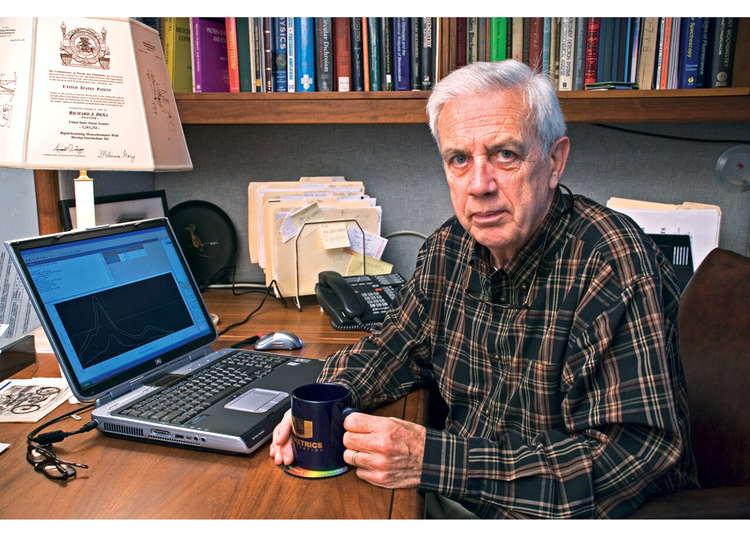Uv/vis/nir Fundamentals Explained
Uv/vis/nir Fundamentals Explained
Blog Article
See This Report on Uv/vis/nir
Table of ContentsNot known Factual Statements About Circularly Polarized Luminescence All About SpectrophotometersA Biased View of SpectrophotometersSome Known Factual Statements About Spectrophotometers Uv/vis/nir - Questions

Although spectrophotometry is most commonly used to ultraviolet, noticeable, and infrared radiation, contemporary spectrophotometers can question large swaths of the electro-magnetic spectrum, consisting of x-ray, ultraviolet, visible, infrared, and/or microwave wavelengths. Spectrophotometry is a tool that depends upon the quantitative analysis of molecules depending on how much light is soaked up by colored substances.
3 Easy Facts About Uv/vis Explained
A spectrophotometer is typically used for the measurement of transmittance or reflectance of solutions, transparent or nontransparent solids, such as refined glass, or gases. Although numerous biochemicals are colored, as in, they soak up noticeable light and for that reason can be determined by colorimetric procedures, even colorless biochemicals can frequently be transformed to colored compounds ideal for chromogenic color-forming responses to yield compounds ideal for colorimetric analysis.: 65 However, they can likewise be designed to measure the diffusivity on any of the noted light varieties that typically cover around 2002500 nm utilizing various controls and calibrations.
An example of an experiment in which spectrophotometry is utilized is the determination of the balance constant of a solution. A specific chain reaction within a service might occur in a forward and reverse direction, where reactants form products and items break down into reactants. Eventually, this chain reaction will reach a point of balance called a stability point.
Little Known Questions About Circularly Polarized Luminescence.
The amount of light that travels through the service is a sign of the concentration of particular chemicals that do not permit light to travel through. The absorption of light is because of the interaction of light with the electronic and vibrational modes of particles. Each type of particle has an individual set of energy levels related to the makeup of its chemical bonds and nuclei and thus will absorb light of particular wavelengths, or energies, resulting in unique spectral properties.
They are commonly utilized in numerous industries including semiconductors, laser and optical manufacturing, printing and forensic assessment, as well as in labs for the research study of chemical substances. Spectrophotometry is often used in measurements of enzyme activities, decisions of protein concentrations, decisions of enzymatic kinetic constants, and measurements of ligand binding reactions.: 65 Eventually, a spectrophotometer is able to determine, depending on the control or calibration, what substances are present in a target and precisely how much through computations of observed wavelengths.
This would come as a solution to the previously created spectrophotometers which were unable to soak up the ultraviolet correctly.
The 7-Second Trick For Uv/vis
It would be found that this did not give satisfactory results, therefore in Model B, there was a shift from a glass to a quartz prism which enabled better absorbance outcomes - UV/Vis/NIR (https://sketchfab.com/olisclarity1). From there, Design C was born with a modification to the wavelength resolution which wound up having 3 units of it produced
It was produced from 1941 to 1976 where the rate for it in 1941 was US$723 (far-UV devices were an option at extra cost). In the words of Nobel chemistry laureate Bruce Merrifield, it was "probably the most crucial instrument ever developed towards the development of bioscience." Once it became terminated in 1976, Hewlett-Packard created the first commercially available diode-array spectrophotometer in 1979 called the HP 8450A. It irradiates the sample with polychromatic light which the sample absorbs depending upon its properties. Then it is transmitted back by grating the photodiode variety which detects the wavelength region of the spectrum. Given that then, the development and execution of spectrophotometry devices has increased immensely and has turned into one of the most innovative instruments of our time.

Spectrophotometers Things To Know Before You Buy
Historically, spectrophotometers use a monochromator including a diffraction grating to produce the analytical spectrum. The grating can either be movable or fixed. If a single detector, such as a photomultiplier tube or photodiode is used, the grating can be scanned stepwise (scanning spectrophotometer) so that the detector can measure the light intensity at each wavelength (which will correspond to each "action").
In such systems, the grating is fixed and the intensity of each wavelength of light is determined by a various detector in the range. Furthermore, most modern-day mid-infrared spectrophotometers use a Fourier change technique to get the spectral info - https://www.cybo.com/US-biz/on-line-instrument-systems-olis-inc. This strategy is called Fourier transform infrared spectroscopy. When making transmission measurements, the spectrophotometer quantitatively compares the fraction of light that travels through a referral option and a test service, then digitally compares the intensities of the two signals and calculates the percentage of transmission of the sample compared to the reference requirement.

Report this page